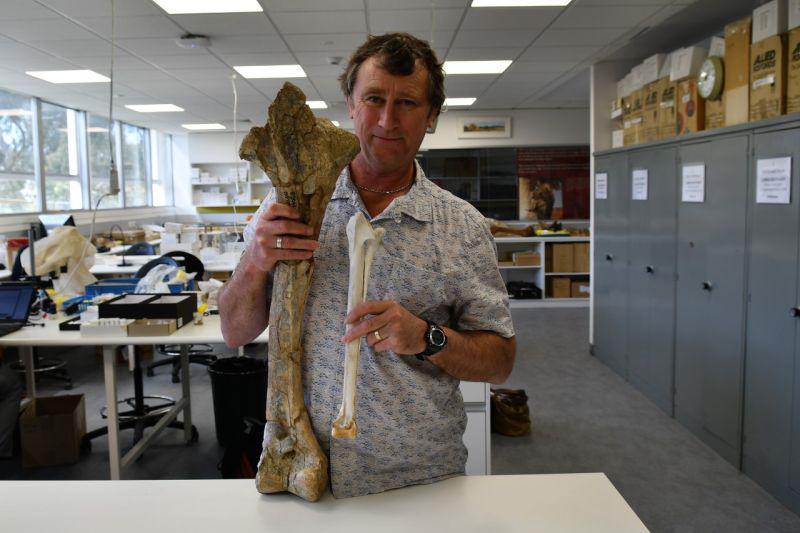Science New Study Explains The Demise Of The Biggest Birds On The Planet David Bressan Contributor Opinions expressed by Forbes Contributors are their own. I deal with the rocky road to our modern understanding of earth New! Follow this author to stay notified about their latest stories. Got it! Aug 24, 2022, 07:17am EDT | New! Click on the conversation bubble to join the conversation Got it! Share to Facebook Share to Twitter Share to Linkedin Study co-author associate professor Trevor Worthy comparing a fossil shinbone of the giant mihirung .
. . [+] bird with a modern-day emu bone.
Flinders University Dromornithidae, known as mihirungs (the Aboriginal name for the bird) and informally as thunder birds or demon ducks (as they are related to modern waterfowls), were a clade of large, flightless birds towering over the Australian bush for some 30 million years. Dromornithid bones excavated in the northern reaches of the Flinders Ranges, South Australia, and near Alice Springs, Northern Territory, have yielded new insights into their slow breeding patterns and how this could have contributed to their extinction. “We studied thin sections of the fossilised bones of these thunder birds under the microscope so that we could identify the biological signals recorded within.
The microscopic structure of their bones gives us information about how long they took to reach adult size, when they reached sexual maturity, and we can even tell when the females were ovulating,” ” says study author professor Anusuya Chinsamy-Turan , University of Cape Town, South Africa. “Questions, such as how long these gigantic birds took to reach adult size and sexual maturity, are key to understand their evolutionary success and their ultimate failure to survive alongside humans. ” The researchers compared the bones of the oldest and largest mihirung Dromornis stirtoni, which lived 7 million years ago, stood up to 3 meters tall, and had a mass of up to 600 kilograms, with the late Pleistocene species Genyornis newtoni – the last and smallest mihirung with a body mass around 240 kilograms.
MORE FOR YOU New Research Finds A Connection Between Domestic Violence And These Two Personality Disorders This Scientist Helps Andean Forests And Ecuador’s Women In STEM Exceptional Fossil Preservation Suggests That Discovering Dinosaur DNA May Not Be Impossible Dromornis artist’s impression Peter Trusler/Flinders University The study indicates that Dromornis stirtoni – arguably the largest bird ever to live on Earth – took a long time to grow to full body size and to become sexually mature, possibly up to 15 years. On the other hand, Genyornis newtoni grew faster than the first mihirung, likely reaching adult size within a few years and starting breeding soon thereafter. However, their growth was still quite slow compared to nearly all modern birds that reach adult size in a year and can breed in the second year of their life.
The last mihirungs shared their environment also with early emus , now the world’s third-largest bird. Emu grow to full adult size and breed within 1 to 2 years. This type of breeding strategy allows their populations to rebound when favourable conditions return after periods of drought or food shortages which could cause population declines.
In the past, mihirung birds survived climate shifts and unpredictable droughts, but 50,000 to 10,000 years ago humans started to burn down the bushland and hunt the large animals. The differing breeding strategies displayed by emus and dromornithids gave the emu a key advantage when the paths of these birds crossed with humans, with the last of the dromornithids goings extinct about 40 thousand years ago. “Sadly for these amazing animals, which already faced rising challenges of climate change as the interior of Australia became hotter and dryer, their breeding biology and size couldn’t match the more rapid breeding cycle of modern day (smaller) emus to keep pace with these more demanding environmental conditions,” the researchers conclude.
The paper ” Osteohistology of Dromornis stirtoni (Aves: Dromornithidae) and the biological implications of the bone histology of the Australian mihirung birds ” is published in The Anatomical Record (2022). Materials provided by Flinders University. David Bressan Editorial Standards Print Reprints & Permissions.
From: forbes
URL: https://www.forbes.com/sites/davidbressan/2022/08/24/new-study-explains-the-demise-of-the-biggest-birds-on-the-planet/



